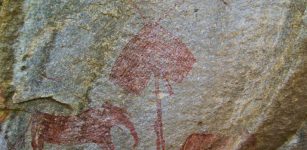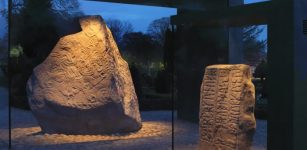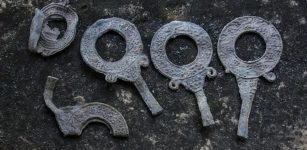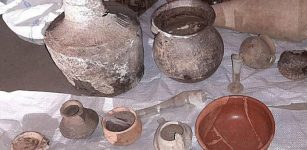Unraveling The Mystery Of The Phoenix Bird – Symbol Of The Sun And Eternal Rebirth Of Life
A. Sutherland - AncientPages.com - What is behind the story of Phoenix, the bird of immortality that rises from the ashes?
The Phoenix is known in various forms and names throughout the Middle and the Far East, the Mediterranean, and Europe. It is a symbol of resurrection.
Phoenix - Mythological Bird. In Greece, the phoenix rising from flames was the symbol of the First Hellenic Republic under Ioannis Kapodistrias, the Mountain Government and the Regime of the Colonels. Imge credit: Diafora - CC BY-SA 3.0
The name Phoenix may have come from the Greek phoînix and may be related to phoinos (blood-red).
In ancient Egypt, the Phoenix was called the "Lord of Jubilees" and was considered the ba (spirit) of the Sun God Ra. In Mesopotamia, the Phoenix is symbolized by the horned and winged solar disk. Alchemists used the Phoenix to represent the color red and the successful end of a process.
The medieval Hermeticists used the Phoenix as a symbol of alchemical transmutation.
Legends tell that the Phoenix had red and gold feathers, the rising Sun's color. It had a wonderfully melodious voice, which became mournful with approaching death. Other creatures were then so overcome by its beauty and sadness that they fell dead.
Ornament from a book of typographic specimens, 1870. Image source
From ancient texts, we learn that only one Phoenix could live at a time. Hesiod, the Greek poet, wrote that the Phoenix lived nine times the lifespan of the long-living raven. According to other sources, the Phoenix can live up to 97,200 years.
Tacitus (AD 56 – c. 120), a Roman historian and politician, is widely regarded as one of the prominent Roman historians by modern scholars. He said that "in the consulship of Paulus Fabius (AD 34), the miraculous bird known to the world by the name of the Phoenix, after disappearing for a series of ages, revisited Egypt. It was attended in its flight by various birds, all attracted by the novelty and gazing with wonder at its beautiful appearance."
Also, Herodotus' words are beautiful when he talks about the amazing Phoenix: "I have not seen it myself, except in a picture. Part of his plumage is gold-colored, and part crimson; and he is for the most part very much like an eagle in outline and bulk..."
 Egyptian Ba bird - the "ba," depicted as a human-headed falcon, was a spiritual aspect of one's personality. Image credit: Walters Art Museum - Public domain
Egyptian Ba bird - the "ba," depicted as a human-headed falcon, was a spiritual aspect of one's personality. Image credit: Walters Art Museum - Public domain
Pliny beliueved that there was to be only one Phoenix in the world, purple in color, with a golden head and a blue-pink tail, and with a crest of feathers on its head. He lived for 540 years, and then, it was time for him to built a nest of spices, in which he died. Tradition says that the Phoenix fed only on air, harming no other creature. It lived a solitary life in a faraway land, coming to a human-inhabited land only when it was ready to die. If the bird was injured, it possessed the power to heal itself.
When the Phoenix reaches the end of his life, it sets the nest and itself on fire and is burned to ashes. Shortly, the Phoenix rises again and begins its life anew. In some traditions, the new Phoenix gathers the old ashes and takes them to the Egyptian city of Heliopolis to offer them to the Sun God. The ashes laid on the Altar of the Sun are said to have the power to bring a dead man back to life.
When the Roman emperor Elagabalus (203-222) tried to become immortal, he dined off a bird of paradise, sent in place of a phoenix, but the substitute did not work. Instead, the emperor was murdered shortly afterward.
Death of the Phoenix burning in flames (medieval Aberdeen Bestiary). Image credit: Phoenix7777 - CC0 1.0
Unfortunately, there is little information about the Phoenix, the bird of flames.
Some people firmly believe that it is God's pet, let loose on the world now and again to give the people a glimpse of God's powers. Others swear that the Phoenix is a God, the incarnation of Foiros, bringing peace to the righteous and swift retribution to the evil and corrupt.
Yet another group says it is not more than a near-extinct animal, no different from a swan or dove. So far, scholars have been unable to trace the true origin of the Phoenix legend. It is believed, but not confident, that the legend came from the Orient and was adopted by Sun-worshipping priests of Heliopolis as an allegory of the Sun's daily setting and rebirth.
In Christianity, the resurrected Phoenix became a famous symbol for how Jesus Christ has risen from the grave.
The legend of this beautiful supernatural creature has survived for centuries. The Phoenix never died permanently. Legend says it existed when the universe was created.
It knows the secrets of life and reincarnation, knowledge even the most powerful gods do not possess.
Written by – A. Sutherland - AncientPages.com Senior Staff Writer
Updated on November 6, 2023
Copyright © AncientPages.com All rights reserved. This material may not be published, broadcast, rewritten or redistributed in whole or part without the express written permission of AncientPages.com
Expand for referencesReferences:
Nigg J. The Phoenix: An Unnatural Biography of a Mythical Beast
Bulfinch, Thomas. Bulfinch's Mythology
Pliny the Elder: Natural History, Books XXX
More From Ancient Pages
-
 Completely Intact 2,000-Year-Old ‘Chocolatier Style’ Pot Discovered In Mexican Cave
Archaeology | Jul 30, 2022
Completely Intact 2,000-Year-Old ‘Chocolatier Style’ Pot Discovered In Mexican Cave
Archaeology | Jul 30, 2022 -
 Mnemosyne: Powerful Greek Goddess Of Memory, Bridge Between The Past And The Future
Featured Stories | Aug 2, 2021
Mnemosyne: Powerful Greek Goddess Of Memory, Bridge Between The Past And The Future
Featured Stories | Aug 2, 2021 -
 Legendary Grianán Of Aileach Built By God Dagda Of Tuatha De Danann Was Once The Royal Seat Of The Kingdom Of Ailech
Featured Stories | May 13, 2021
Legendary Grianán Of Aileach Built By God Dagda Of Tuatha De Danann Was Once The Royal Seat Of The Kingdom Of Ailech
Featured Stories | May 13, 2021 -
 On This Day In History: First European Sights The Ruins Of Ancient Maya City Of Copán – On Mar 8, 1576
News | Mar 8, 2017
On This Day In History: First European Sights The Ruins Of Ancient Maya City Of Copán – On Mar 8, 1576
News | Mar 8, 2017 -
 Attempt To Smuggle Three Artefacts From Alexandria Port – Failed
Artifacts | Oct 28, 2020
Attempt To Smuggle Three Artefacts From Alexandria Port – Failed
Artifacts | Oct 28, 2020 -
 Sibylline Books: Ancient Prophecies Destroyed By Fire
Featured Stories | Feb 17, 2016
Sibylline Books: Ancient Prophecies Destroyed By Fire
Featured Stories | Feb 17, 2016 -
 Fascinating Slavic Mythology Offers Surprising Insight Into The Mystery Of Reincarnation
Featured Stories | Oct 13, 2015
Fascinating Slavic Mythology Offers Surprising Insight Into The Mystery Of Reincarnation
Featured Stories | Oct 13, 2015 -
 Hundreds Of Rock Paintings Found In Tanzania By Polish Archaeologist
Archaeology | Jul 11, 2018
Hundreds Of Rock Paintings Found In Tanzania By Polish Archaeologist
Archaeology | Jul 11, 2018 -
 Archaeologists Shed Light On The Lives Of Stone Age Hunter-Gatherers In Britain
Archaeology | Jan 20, 2023
Archaeologists Shed Light On The Lives Of Stone Age Hunter-Gatherers In Britain
Archaeology | Jan 20, 2023 -
 How The Horseshoe Became A Symbol Of Good Luck
Ancient Idioms & Superstitions | Jan 28, 2017
How The Horseshoe Became A Symbol Of Good Luck
Ancient Idioms & Superstitions | Jan 28, 2017 -
 3D Scans Of Runestones Reveal The Power Of Viking Queen Thyra
Archaeology | Oct 13, 2023
3D Scans Of Runestones Reveal The Power Of Viking Queen Thyra
Archaeology | Oct 13, 2023 -
 8,000-Year-Old Nephrite ‘Frog-Like’ Swastika In Bulgaria’s Neolithic Settlement – Unearthed
Archaeology | Dec 8, 2015
8,000-Year-Old Nephrite ‘Frog-Like’ Swastika In Bulgaria’s Neolithic Settlement – Unearthed
Archaeology | Dec 8, 2015 -
 Five Ancient Mirror Frames, Ceramics Factory Found In Intriguing Roman Villa In Pavlikeni, Bulgaria
Archaeology | Mar 13, 2018
Five Ancient Mirror Frames, Ceramics Factory Found In Intriguing Roman Villa In Pavlikeni, Bulgaria
Archaeology | Mar 13, 2018 -
 Michael Scott – Fascinating Wizard Who Tutored The Holy Roman Emperor Frederick II
Featured Stories | Mar 7, 2025
Michael Scott – Fascinating Wizard Who Tutored The Holy Roman Emperor Frederick II
Featured Stories | Mar 7, 2025 -
 Europol Reports: ‘Millions’ In Stolen Treasures After Busting Crime Gang In Bulgaria – Recovered
Archaeology | Jul 4, 2020
Europol Reports: ‘Millions’ In Stolen Treasures After Busting Crime Gang In Bulgaria – Recovered
Archaeology | Jul 4, 2020 -
 How Far South Did Prehistoric Highly Skilled Polynesian Seafarers Sail?
Archaeology | Nov 1, 2024
How Far South Did Prehistoric Highly Skilled Polynesian Seafarers Sail?
Archaeology | Nov 1, 2024 -
 Ullikummi – Genderless, Blind, Deaf Rock Monster Created For Strategic Purposes In Beliefs Of Hurrian People
Featured Stories | Feb 26, 2025
Ullikummi – Genderless, Blind, Deaf Rock Monster Created For Strategic Purposes In Beliefs Of Hurrian People
Featured Stories | Feb 26, 2025 -
 Ancient Human Remains Buried In Spanish Caves Were Subsequently Manipulated And Utilized
Archaeology | Sep 21, 2023
Ancient Human Remains Buried In Spanish Caves Were Subsequently Manipulated And Utilized
Archaeology | Sep 21, 2023 -
 Ten Ancient Jugs May Reveal The Location Of The Biblical Tabernacle
Archaeology | Jul 21, 2017
Ten Ancient Jugs May Reveal The Location Of The Biblical Tabernacle
Archaeology | Jul 21, 2017 -
 Four Rare And Incredibly Well-Preserved 1,900-Year-Old Roman Swords Found In Judean Desert
Archaeology | Sep 6, 2023
Four Rare And Incredibly Well-Preserved 1,900-Year-Old Roman Swords Found In Judean Desert
Archaeology | Sep 6, 2023



